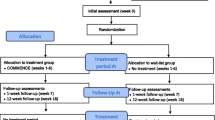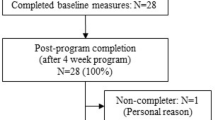Abstract
The objective of this study was to assess the effect of clinical depression on pain self-management practices. We employed a cross-sectional analysis of baseline data from the Stepped Care for Affective disorders and Musculoskeletal Pain (SCAMP) study. Participants included 250 patients with pain and comorbid depression and 250 patients with pain only and were enrolled from urban university and VA primary care clinics. Musculoskeletal pain was defined as low back, hip or knee pain present ≥3 months and with at least a moderate, Brief Pain Inventory severity score ≥5. Depression was defined as a PHQ-9 score ≥10. We used multiple logistic and Poisson regression to assess the relationship between individual and combined effects of depression and pain severity on two core pain self-management skills: exercise duration and cognitive strategies. Depressed patients exercised less per week than did nondepressed patients but showed a trend towards more frequent use of cognitive strategies. On multivariable analysis, depression severity substantially decreased the use of exercise as a pain self-management strategy. In contrast, depression and pain severity interacted to increase the use of cognitive strategies. Depression and pain severity have differential effects on self-management practices. Understanding the differences between preferential strategies of pain patients with and without depression may be useful in tailoring pain self-management programs.

Similar content being viewed by others
References
Bair, M. J., Robinson, R. L., Katon, W., & Kroenke, K. (2003). Depression and pain comorbidity. Archives of Internal Medicine, 163, 2433–2445. doi:10.1001/archinte.163.20.2433.
Barry, L. C., Kerns, R. D., Guo, Z., Duong, B. D., Iannone, L. P., & Reid, M. C. (2004). Identification of strategies used to cope with chronic pain in older persons receiving primary care from a Veterans Affairs Medical Center. Journal of American Geriatric Society, 52, 950–956. doi:10.1111/j.1532-5415.2004.52263.x.
Bayliss, E. A., Bosworth, H. B., Noel, P. H., Wolff, J. L., Damush, T. M., & McIvor, L. (2007). Supporting self-management for patients with complex medical needs: Recommendations of a working group. Chronic Illness, 3, 167–175. doi:10.1177/1742395307081501.
Bigos, S., Bowyer, O., Braen, G., et al. (1994). Acute low back problems in adults: Clinical practice guideline number 14. AHCPR Publication No. 95-0642. Rockville (MD): Agency for Health Care Policy and Research.
Bodenheimer, T., Lorig, K., Holman, H., & Grumbach, K. (2002). Patient self-management of chronic disease in primary care. Journal of the American Medical Association, 288, 2469–2475. doi:10.1001/jama.288.19.2469.
Callahan, C. M., Unverzagt, F. W., Hui, S. L., Perkins, A. J., & Hendrie, H. C. (2002). A six-item screener to identify cognitive impairment among potential subjects for clinical research. Medical Care, 40, 771–781. doi:10.1097/00005650-200209000-00007.
Chodosh, J., Morton, S. C., Mojica, W., Maglione, M, Suttorp, M. J., Hilton, L, Rhodes, S., & Shekelle, P. (2005). Meta-analysis: Chronic disease self-management programs for older adults. Annals of Internal Medicine, 143, 427–438.
Cleeland, C. S. (1989). Measurement of pain by subjective report. In K. M. Foley (Ed.), Advances in pain research and therapy (pp. 391–403).
Cleeland, C. S., Gonin, R., Hatfield, A. K., Edmonson, J. H., Blum, R. H., Stewart, J. A., et al. (1994). Pain and its treatment in outpatients with metastatic cancer. New England Journal of Medicine, 330, 592–596. doi:10.1056/NEJM199403033300902.
Damush, T. M., Weinberger, M., Perkins, S. M., Rao, J. K., Tierney, W. M., Rong, Q., & Clark, D. O. (2003a). The long-term effects of a self-management program for inner-city, primary care patients with acute low back pain. Archives of Internal Medicine, 163, 2632–2638. doi:10.1001/archinte.163.21.2632.
Damush, T. M., Weinberger, M., Tierney, W. M., Rao, J. K., Clark, D. O., & Perkins, S. M. (2003b). A randomized trial of a self-management program for primary care patients with acute low back pain: short-term effects. Arthritis & Rheumatism, 49, 179–186. doi:10.1002/art.10995.
Das-Munshi, J., Stewart, R., Ismail, K, Bebbington, P. E., Jenkins, R., & Prince, M. J. (2007). Diabetes, common mental disorders, and disability: Findings from the UK National Psychiatric Morbidity Survey. Psychosomatic Medicine, 69, 543–550. doi:10.1097/PSY.0b013e3180cc3062.
Deyo, R. A., Cherkin, D., Conrad, D., & Volinn, E. (1991). Cost, controversy, crisis: Low back pain and the health of the public. Annual Review of Public Health, 12, 141–156. doi:10.1146/annurev.pu.12.050191.001041.
Deyo, R. A., Mirza, S. K., & Martin, B. I. (2002). Back pain prevalence and visit rates. Spine, 31, 2724–2727. doi:10.1097/01.brs.0000244618.06877.cd.
Dixon, K. E., Keefe, F. J., Scipio, C. D., Perri, L. M., & Abernethy, A. P. (2007). Psychological interventions for arthritis pain management in adults: A meta-analysis. Health Psychology, 26, 241–250. doi:10.1037/0278-6133.26.3.241.
Felson, D. T., Niu, J., McClennan, C., et al. (2007). Knee buckling: prevalence, risk factors, and associated limitations in function. Annals of Internal Medicine, 147, 534–540.
Frymoyer, J. W., & Cats-Baril, W. L. (1991). An overview of the incidence and costs of low back pain. Orthopedic Clinics of North America, 22, 263–271.
Gonzalez, J. S., Safren, S. A., Cagliero, E., Wexler, D. J., Delahanty, L., Wittenberg, E., Blais, M. A., Meigs, J. B., & Grant, R. W. (2007). Depression, self-care, and medication adherence in type 2 diabetes: Relationships across the full range of symptom severity. Diabetes Care, 30, 2222–2227. doi:10.2337/dc07-0158.
Kerns, R. D., Rosenberg, R., Jamison, R. N., Caudill, M. A., & Haythornthwaite, J. (1997). Readiness to adopt a self-management approach to chronic pain: The pain stages of change questionnaire (PSOCQ). Pain, 72, 227–234. doi:10.1016/S0304-3959(97)00038-9.
Krein, S. L., Heisler, M., Piette, J.D., Makki, F., & Kerr, E. A. (2005). The effect of chronic pain on diabetes patients’ self-management. Diabetes Care, 28, 65–70.
Kroenke, K. (2003). Patients presenting with somatic complaints: Epidemiology, psychiatric comorbidity and management. International Journal of Methods for Psychiatric Research, 12, 34–43. doi:10.1002/mpr.140.
Kroenke, K., Bair, M., Damush, T., Hoke, S., Nicholas, G., Kempf, C., Huffman, M., Wu, J., & Sutherland, J. (2007). Stepped care for affective disorders and musculoskeletal pain (SCAMP) study: Design and practical implications of an intervention for comorbid pain and depression. General Hospital Psychiatry, 29(6), 506–517.
Kroenke, K., Spitzer, R. L., & Williams, J. B. W. (2001). The PHQ-9: Validity of a brief depression severity measure. Journal of General Internal Medicine, 16, 606–613. doi:10.1046/j.1525-1497.2001.016009606.x.
Kroenke, K., West, S. L., Swindle, R., Gilsenan, A., Eckert, G., et al. (2001). Comparable effectiveness of paroxetine, fluoxetine, and sertraline in primary care: A randomized trial. Journal of the American Medical Association, 286, 2947–2955. doi:10.1001/jama.286.23.2947.
Lorig, K. (2003). Self-management education: More than a nice extra. Medical Care, 41, 699–701. doi:10.1097/00005650-200306000-00001.
Lorig, K., & Fries, J. F. (1996). The arthritis helpbook (4th ed.). Reading, MA: Addison-Wesley Publishing Company.
Lorig, K., Gonzalez, V. M., Laurent, D. D., Morgan, L., & Laris, B. A. (1998). Arthritis self-management program variations: Three studies. Arthritis Care Research, 11, 448–454. doi:10.1002/art.1790110604.
Lorig, K. R., & Holman, H. (2003). Self-management education: History, definition, outcomes and mechanisms. Annals of Behavioral Medicine, 26, 1–7. doi:10.1207/S15324796ABM2601_01.
Lorig, K. R., Mazonson, P. D., & Holman, H. R. (1993). Evidence suggesting that health education for self-management in patients with chronic arthritis has sustained health benefits while reducing health care costs. Arthritis and Rheumatology, 36, 439–446. doi:10.1002/art.1780360403.
Lorig, K., Stewart, A., Ritter, P., Gonzalez, V., Laurent, D., & Lynch, J. (1996). Outcome measures for health education and other health care interventions. Thousand Oaks, CA: Sage Publications, Inc.
Parsons, S., Breen, A., Foster, N. E., Letley, L., Pincus, T., Vogel, S., & Underwood, M. (2007). Prevalence and comparative troublesomeness by age of musculoskeletal pain in different body locations. Family Practice, 4, 1–9.
Perkins, A. J., Kroenke, K., Unutzer, J., Katon, W., Williams, J. W., Hope, C., et al. (2004). Common comorbidity scales were similar in their ability to predict health care costs and mortality. Journal of Clinical Epidemiology, 57, 1040–1048. doi:10.1016/j.jclinepi.2004.03.002.
Riegel, B., Vaughan Dickson, V., Goldberg, L. R., & Deatrick, J. A. (2007). Factors associated with the development of expertise in heart failure self-care. Nursing Research, 56, 235–243. doi:10.1097/01.NNR.0000280615.75447.f7.
Rokke, P. D., Tomhave, J. A., & Jocic, Z. (1999). The role of client choice and target selection in self-management therapy for depression in older adults. Psychology and Aging, 14, 155–169. doi:10.1037/0882-7974.14.1.155.
Sullivan, M. J. L., Adams, H., Tripp, D., & Stanish, W. D. (2007). Stage of chronicity and treatment response in patients with musculoskeletal injuries and concurrent symptoms of depression. Pain Eprint doi:10.1016/j.pain.2007.05.021.
Trivedi, M. H. (2004). The link between depression and physical symptoms. Primary Care Companion Journal of Clinical Psychiatry, 6, 12–16.
Unutzer, J., Katon, W., Callahan, C. M., Williams, J., et al (2002). Collaborative care management of late-life depression in the primary care setting: A randomized controlled trial. Journal of the American Medical Association, 288, 2836–2845.
Veterans Health Administration/Department of Defense (VHA/DOD) performance measures for the management of major depressive disorder in adults. VHA/DOD working group. Contract Number V101(93)P-1633. 15 March 2000.
Von Korff, M., Balderson, B. H. K., Saunders, K., Miglioretti, D. L., Lin, E. H. B., Berry, S., Moore, J. E., & Turner, J. A. (2005). A trial of an activating intervention for chronic back pain in primary care and physical therapy settings. Pain, 113, 323–330. doi:10.1016/j.pain.2004.11.007.
Von Korff, M., & Moore, J. E. (2001). Stepped care for back pain: Activating approaches for primary care. Annals of Internal Medicine, 134, 911–917.
Von Korff, M., Moore, J. E., Lorig, K., Cherkin, D. C., Saunders, K., Gonzalez, V. M., et al. (1998). A randomized trial of a lay person-led self-management group intervention for back pain patients in primary care. Spine, 23, 2608–2615. doi:10.1097/00007632-199812010-00016.
Williams, L. S., Jones, W. J., Shen, J., Robinson, R. L., Weinberger, M., & Kroenke, K. (2003). Prevalence and impact of pain and depression in neurology outpatients. Journal of Neurology and Neurosurgical Psychiatry, 74, 1587–1589.
Wipf, J. E., & Deyo, R. A. (1995) Low back pain. Medicine Clinics of North America, 79, 231–246.
Acknowledgement
This study was supported by a grant from the National Institute of Mental Health to Dr. Kroenke (MH-071268).
Author information
Authors and Affiliations
Corresponding author
Rights and permissions
About this article
Cite this article
Damush, T.M., Wu, J., Bair, M.J. et al. Self-management practices among primary care patients with musculoskeletal pain and depression. J Behav Med 31, 301–307 (2008). https://doi.org/10.1007/s10865-008-9156-5
Received:
Accepted:
Published:
Issue Date:
DOI: https://doi.org/10.1007/s10865-008-9156-5




